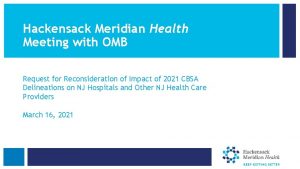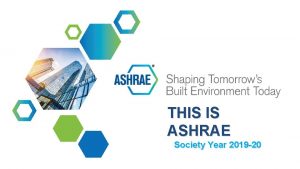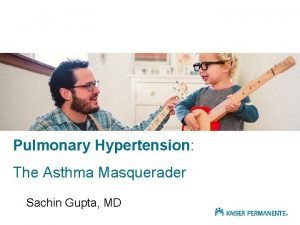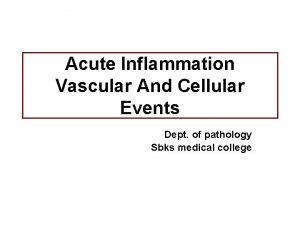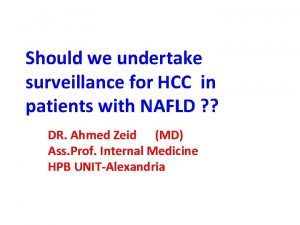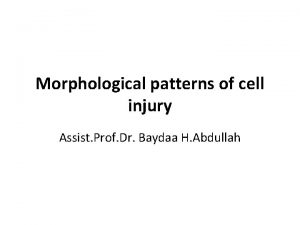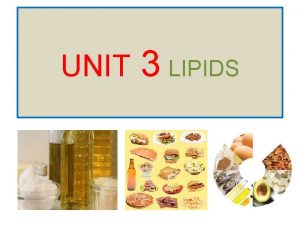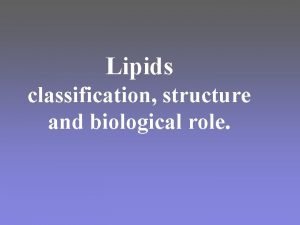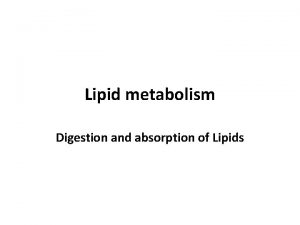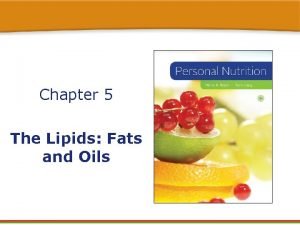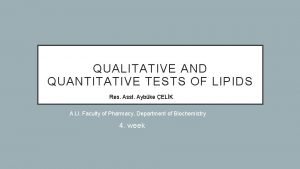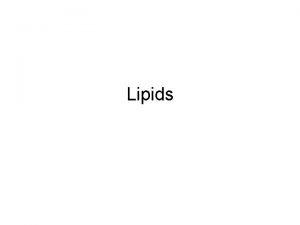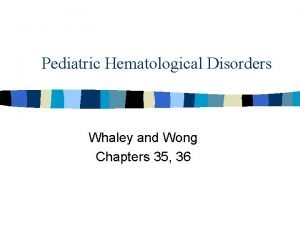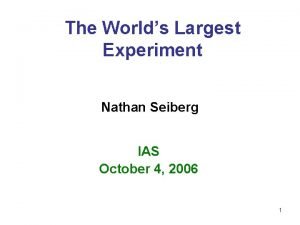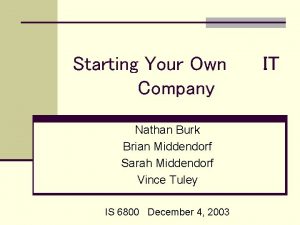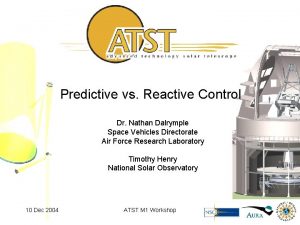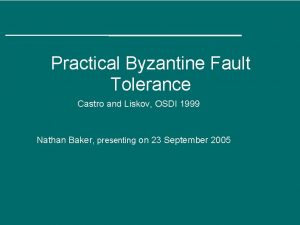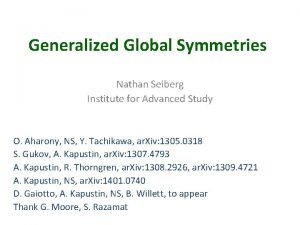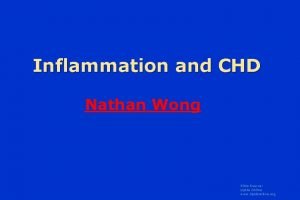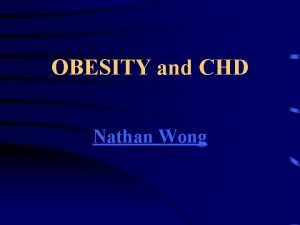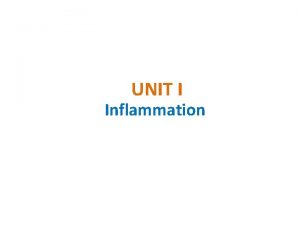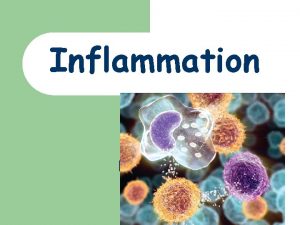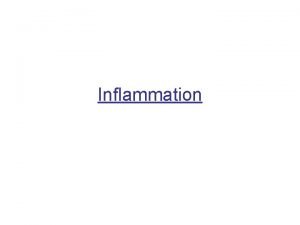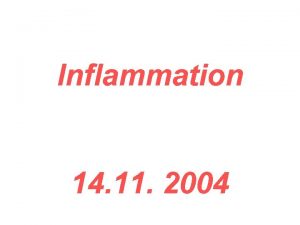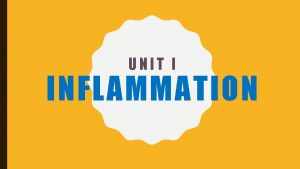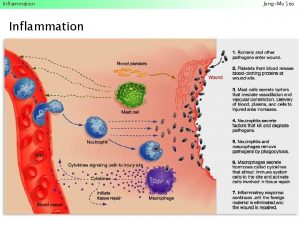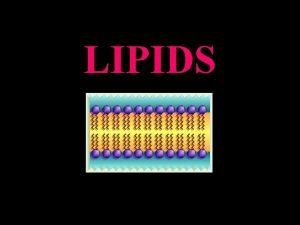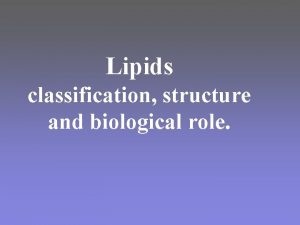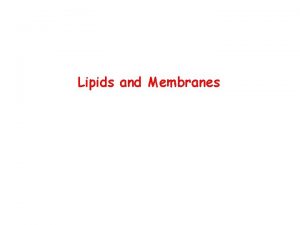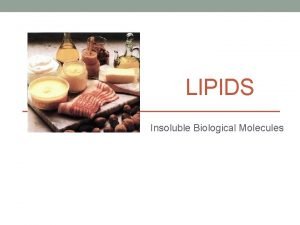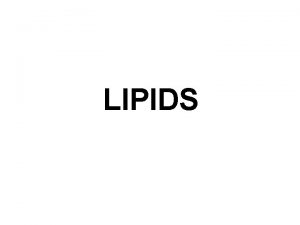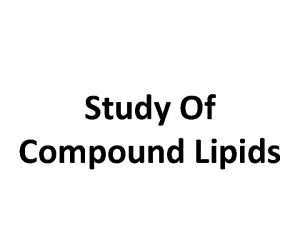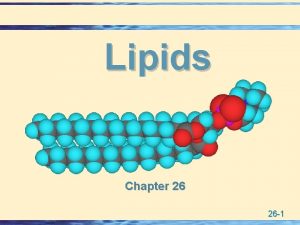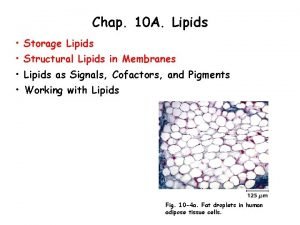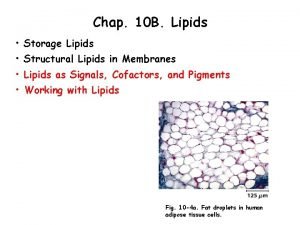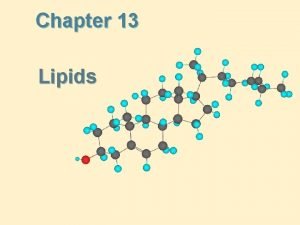Inflammation and CHD Nathan Wong Slide Source Lipids

































- Slides: 33

Inflammation and CHD Nathan Wong Slide Source: Lipids Online www. lipidsonline. org

Thrombosis, Inflammation, and Infection n Many persons experiencing cardiovascular events often do not have well-recognized standard risk factors such as elevated cholesterol or hypertension. n Thrombosis, local or systemic inflammation, and chronic infection may play important roles in the initiation and progression of CHD Slide Source: Lipids Online www. lipidsonline. org

Beyond Cholesterol: Predicting Cardiovascular Risk In the 21 st Century Cardiovascular Risk Lipids HTN Diabetes Behavioral Hemostatic Inflammatory Genetic Thrombotic Slide Source: Lipids Online www. lipidsonline. org

Total Cholesterol Distribution: CHD vs Non-CHD Population Framingham Heart Study— 26 -Year Follow-up No CHD 35% of CHD Occurs in People with TC<200 mg/d. L 150 CHD 200 250 300 Total Cholesterol (mg/d. L) Slide Source: Lipids Online www. lipidsonline. org

Inflammation and Atherosclerosis n Inflammation may determine plaque stability - Unstable plaques have increased leukocytic infiltrates - T cells, macrophages predominate rupture sites - Cytokines and metalloproteinases influence both stability and degradation of the fibrous cap n Lipid lowering may reduce plaque inflammation - Decreased macrophage number - Decreased expression of collagenolytic enzymes (MMP-1) - Increased interstitial collagen - Decreased expression of E-selectin - Reduced calcium deposition Slide Source: Lipids Online www. lipidsonline. org

Is there clinical evidence that inflammatory markers predict future coronary events and provide additional predictive information beyond traditional risk factors? Slide Source: Lipids Online www. lipidsonline. org

Evaluating Novel Risk Factors for CAD n Consistency of prospective data n Strength of association n Independence of association n Improve predictive value n Standardized measure n Low variability n High reproducibility n Biologic plausibility n Low cost n Modifiable Slide Source: Lipids Online www. lipidsonline. org

Biomarkers for Venous and Arterial Thrombosis Parameter Venous Arterial Fibrinogen – +++ Factor VII – + v. WF: ag – ++ t. PA: ag – +++ PAI-1: ag – ++ Platelet function – ++ Lp(a) – + hs-CRP / SAA / IL-6 / TNF – +++ Slide Source: Lipids Online www. lipidsonline. org

Biomarkers for Venous and Arterial Thrombosis (cont’d) Parameter Venous Arterial +++ – + – Factor VIII ++ – Anti-thrombin III ++ – Protein C + – Protein S + – Homocysteine ++ ++ D-dimer ++ ++ Factor V Leiden Prothrombin mutation Prothrombin Slide Source: Lipids Online www. lipidsonline. org

Thrombosis and Cardiovascular Risk n Thrombus formation is a crucial factor in the precipitation of unstable angina or myocardial infarction, as well as occlusion during or following angioplasty. n Often preceded by platelet aggregation and activation of the coagulation system. n A thrombus may develop at sites of only mild to moderate coronary stenosis. The majority of coronary events occur where there is less than 70% stenosis. n Occlusive coronary thrombosis plays a role in over 80% of myocardial infarctions and about 95% of sudden death victims. Slide Source: Lipids Online www. lipidsonline. org

Fibrinogen and Atherosclerosis n Promotes atherosclerosis n Essential component of platelet aggregation n Relates to fibrin deposited and the size of the clot n Increases plasma viscosity n May also have a proinflammatory role n Measurement of fibrinogen, incl. Test variability, remains difficult. n No known therapies to selectively lower fibrinogen levels in order to test efficacy in CHD risk reduction via clinical trials. Slide Source: Lipids Online www. lipidsonline. org

Fibrinogen and CHD Risk: Epidemiologic Studies n Recent meta-analysis of 18 studies involving 4018 CHD cases showed a relative risk of CHD of 1. 8 (95% CI 1. 6 -2. 0) comparing the highest vs lowest tertile of fibrinogen levels (mean. 35 vs. . 25 g/d. L) n ARIC study in 14, 477 adults aged 45 -64 showed relative risks of 1. 8 in men and 1. 5 in women, attenuated to 1. 5 and 1. 2 after risk factor adjustment. n Scottish Heart Health Study of 5095 men and 4860 women showed fibrinogen to be an independent risk factor for new events--RRs 2. 2 -3. 4 for coronary death and all-cause mortality. Slide Source: Lipids Online www. lipidsonline. org

Fibrinogen and CHD Risk Factors n Fibrinogen levels increase with age and body mass index, and higher cholesterol levels n Smoking can reversibly elevated fibrinogen levels, and cessation of smoking can lower fibrinogen. n Those who exercise, eat vegetarian diets, and consume alcohol have lower levels. Exercise may also lower fibrinogen and plasma viscosity. n Studies also show statin-fibrate combinations (simvastatin-ciprofibrate) and estrogen therapy to lower fibrinogen. Slide Source: Lipids Online www. lipidsonline. org

Other Thrombotic Factors and CHD n Mixed reports of coagulation factor VIIc in cardiovascular disease. PROCAM study showed no association with CHD events, CHS also showed no relation to subclinical CVD. n Endogenous tissue-type plasminogen activator (t. PA) shown in some studies to relate to increased cardiovascular risk--Physician’s Health Study showed RR for MI 2. 8, stroke 3. 5 in those in 5 th vs. 1 st quintile of t. PA. n Plasminogen activitor inhibitor type 1 (PAI-1) shown associated with increased cardiovascular risk, esp in diabetic patients. Slide Source: Lipids Online www. lipidsonline. org

Aspirin and Cardiovascular Risk: Clinical Trial Evidence for Primary Prevention n US Physician’s Health Study- 22, 071 male physicians - 44% reduction in MI risk, 13% nonsignificant increase in risk of stroke n British Doctor’s Study of 5139 male physicians showed nonsignificant 3% reduction in MI risk, 13% nonsignificant increase in stroke n Hypertension Optimal Treatment (HOT) study among 18, 790 pts w/htn showed 15% reduction in CVD events, 36% reduction in MI n Ongoing Women’s Health Study (n=40, 000) Slide Source: Lipids Online www. lipidsonline. org

Aspirin and Cardiovascular Risk: Clinical Trial Evidence for Secondary Prevention n Antiplatelet Trialists Collaboration of 54, 000 patients with cardiovascular disease (10 trials post-MI) showed 31% reduction in MI, 42% reduction in stroke, 13% reduction in total vascular mortality n International Study of Infarct Survival of 17, 187 pts w/evolving MI showed 49% reduction in reinfarction, 26% reduction in nonfatal stroke, and 23% reduction in total vascular mortality Slide Source: Lipids Online www. lipidsonline. org

Antiplatelet Therapy: AHA Recommendations n Aspirin is clearly recommended in secondary prevention. Provides additional benefit in conjunction with thrombolytic therapy. Clopidogrel may be an option in aspirin-intolerant patients. n Aspirin is not recommended for primary prevention in those free of CHD and younger than 50 years old. n Aspirin may be considered in those over age 50 with additional risk factors, free of contraindications, and may benefit those with hypertension, diabetes, and cigarette smoking. n American Diabetes Association recommends aspirin in diabetics with at least one other CHD risk factor. Slide Source: Lipids Online www. lipidsonline. org

Relative Risks of Future MI among Apparently Healthy Middle-Aged Men: Physician’s Health Study Lipoprotein(a) Homocysteine Total Cholesterol Fibrinogen t. PA Antigen TC: HDL-C hs-CRP + TC/HDL-C 0 1. 0 2. 0 4. 0 Relative Risk for Future MI 6. 0 Slide Source: Lipids Online www. lipidsonline. org

Risk Factors for Future Cardiovascular Events: WHS Lipoprotein(a) Homocysteine IL-6 TC LDL-C s. ICAM-1 SAA Apo B TC: HDL-C hs-CRP + TC: HDL-C 0 1. 0 2. 0 4. 0 6. 0 Relative Risk of Future Cardiovascular Events Slide Source: Lipids Online www. lipidsonline. org

CRP vs hs-CRP n CRP is an acute-phase protein produced by the liver in response to cytokine production (IL-6, IL-1, tumor necrosis factor) during tissue injury, inflammation, or infection. n Standard CRP tests determine levels which are increased up to 1, 000 -fold in response to infection or tissue destruction, but cannot adequately assess the normal range n High-sensitivity CRP (hs-CRP) assays (i. e. Dade Behring) detect levels of CRP within the normal range, levels proven to predict future cardiovascular events. Slide Source: Lipids Online www. lipidsonline. org

Potential Mechanisms Linking CRP to Atherothrombosis n Confounding by cigarette consumption n Innocent bystander - Acute phase response n Cytokine surrogate - IL-6, TNF- , IL-1 n Direct effects of CRP - Innate immunity - Complement activation - CAM induction n Prior infection - Chlamydia, H pylori, CMV n Marker for subclinical atherosclerosis - EBCT / IMT / ABI n Marker for insulin resistance/ obesity n Marker for endothelial dysfunction n Marker for dysmetabolic syndrome n Marker for plaque vulnerability Slide Source: Lipids Online www. lipidsonline. org

hs-CRP and Risk of Future MI in Apparently Healthy Men Relative Risk of MI P Trend <0. 001 P < 0. 001 3 0. 115– 0. 210 4 >0. 211 P = 0. 03 1 <0. 055 2 0. 056– 0. 114 Quartile of hs-CRP (range, mg/d. L) Slide Source: Lipids Online www. lipidsonline. org

hs-CRP and Risk of Future Stroke in Apparently Healthy Men P Trend <0. 03 P =0. 02 Relative Risk of Ischemic Stroke P =0. 02 1 <0. 055 2 3 0. 056– 0. 114 0. 115– 0. 210 Quartile of hs-CRP (range, mg/d. L) 4 >0. 211 Slide Source: Lipids Online www. lipidsonline. org

hs-CRP (mg/d. L) hs-CRP and Risk of Developing PVD in Apparently Healthy Men None Intermittent Peripheral Artery Claudication Surgery Slide Source: Lipids Online www. lipidsonline. org

hs-CRP and Risk of Future Cardiovascular Events in Apparently Healthy Women P Trend <0. 002 Relative Risk Any Event MI or Stroke 1 <0. 15 2 0. 15– 0. 37 3 0. 37– 0. 73 Quartile of hs-CRP (range, mg/d. L) 4 >0. 73 Slide Source: Lipids Online www. lipidsonline. org

hs-CRP and Risk of Future Cardiovascular Events in Apparently Healthy Women: Low-Risk Subgroups Relative Risk No hypertension No hyperlipidemia No current smoking No diabetes No family history 1 <0. 15 2 0. 15– 0. 37 3 0. 37– 0. 73 Quartile of hs-CRP (range, mg/d. L) 4 >0. 73 Slide Source: Lipids Online www. lipidsonline. org

Rate Ratio (Age Adjusted) hs-CRP and Coronary Heart Disease in Initially Healthy Men: MONICA–Augsburg Cohort 1 <0. 6 2 0. 6– 1. 1 3 1. 1– 2. 2 4 2. 2– 4. 5 Quartile of CRP (mg/d. L) 5 >4. 5 Slide Source: Lipids Online www. lipidsonline. org

hs-CRP as a Risk Factor for Future CVD MRFIT (Kuller 1996) CHD Death PHS (Ridker 1997) MI PHS (Ridker 1997) Stroke CHS/RHPP PHS (Tracy 1997) (Ridker 1998) WHS (Ridker 1998, 2000) CHD PVD CVD MONICA (Koenig 1999) CHD Helsinki (Roivainen 2000) CHD Caerphilly(Mendall 2000) CHD Britain CHD (Danesh 2000) 0 1. 0 2. 0 3. 0 4. 0 5. 0 6. 0 Relative Risk (upper vs lower quartile) Slide Source: Lipids Online www. lipidsonline. org

hs-CRP Adds to the Predictive Value of Total Cholesterol in Determining Risk of First MI Adjusted Relative Risk P = 0. 001 P = 0. 002 P = 0. 02 CRP >75 th percentile – + TC >75 th percentile – – + + Slide Source: Lipids Online www. lipidsonline. org

hs-CRP Adds to Predictive Value of TC: HDL Ratio in Determining Risk of First MI hs-CRP Total Cholesterol: HDL Ratio Slide Source: Lipids Online www. lipidsonline. org

hs-CRP, Lipids, and Risk of Future Coronary Events: Women's Health Study (WHS) 9 8 7 6 5 4 3 2 1 0 Quartile of TC: 4 HDL-C 3 2 1 1 2 3 4 Quartile of hs-CRP Slide Source: Lipids Online www. lipidsonline. org

Relative Risks for First MI for Baseline s. ICAM-1 >260 ng/d. L Relative Risk 3 2 1 0 0– 1 1– 2 2– 4 Years of Study Follow-up 4– 8 Slide Source: Lipids Online www. lipidsonline. org

Predictivity of Interleukin-6 on CV Risk in Women 4 3 2 1 0 Interleukin-6 High Medium Total cholesterol Low High Medium Slide Source: Lipids Online www. lipidsonline. org
 Heel toe polka music
Heel toe polka music Wong sudra papeki iku tegese wong kang … *
Wong sudra papeki iku tegese wong kang … * Chd meridian healthcare
Chd meridian healthcare Certification study guide: certified hvac designer (chd)
Certification study guide: certified hvac designer (chd) Cjanoza
Cjanoza Sachin gupta md
Sachin gupta md How to factor 4 terms
How to factor 4 terms Nathan and emily green
Nathan and emily green Cellular events of acute inflammation
Cellular events of acute inflammation Cellular events of acute inflammation
Cellular events of acute inflammation Morphology pattern of acute inflammation
Morphology pattern of acute inflammation Cell injury and inflammation
Cell injury and inflammation Dry vs wet gangrene
Dry vs wet gangrene Saponifiable and non saponifiable lipids
Saponifiable and non saponifiable lipids Saponifiable and non saponifiable lipids
Saponifiable and non saponifiable lipids Fat malabsorption
Fat malabsorption Are fats and lipids the same thing
Are fats and lipids the same thing Qualitative tests for lipids lab report
Qualitative tests for lipids lab report Fats and lipids
Fats and lipids Sickledex
Sickledex Nathan dickinson
Nathan dickinson Nathan barrios
Nathan barrios Nathan seiberg
Nathan seiberg Nathan brunelle
Nathan brunelle Nathan burk
Nathan burk Barbara tinning
Barbara tinning Nathan dalrymple
Nathan dalrymple Nathan liskov
Nathan liskov Nathan rinne
Nathan rinne Nathan dalrymple
Nathan dalrymple Nathan seiberg
Nathan seiberg Ackerman family therapy
Ackerman family therapy Dr nathan wegner
Dr nathan wegner Nathan weiss graduate college
Nathan weiss graduate college


